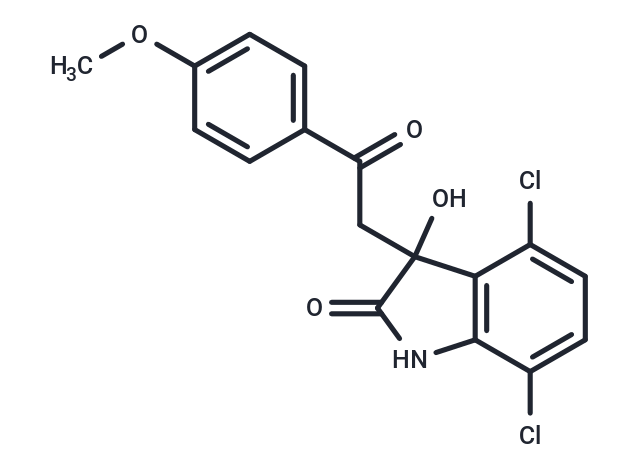Shopping Cart
Remove All Your shopping cart is currently empty
Your shopping cart is currently empty
YK 4-279, an inhibitor of RNA Helicase A (RHA), binds to the oncogenic transciption factor EWS-FLI1.

| Pack Size | Price | USA Warehouse | Global Warehouse | Quantity |
|---|---|---|---|---|
| 5 mg | $54 | In Stock | In Stock | |
| 10 mg | $79 | In Stock | In Stock | |
| 25 mg | $148 | In Stock | In Stock | |
| 50 mg | $277 | In Stock | In Stock | |
| 100 mg | $491 | In Stock | In Stock | |
| 200 mg | $751 | In Stock | - | |
| 1 mL x 10 mM (in DMSO) | $72 | In Stock | In Stock |
| Description | YK 4-279, an inhibitor of RNA Helicase A (RHA), binds to the oncogenic transciption factor EWS-FLI1. |
| In vitro | In the fusion-positive LNCaP-luc-M mouse tumor model, YK-4-279 effectively inhibits tumor cell proliferation and migration. In the in vivo Ewing's Sarcoma Family of Tumors (ESFT) xenografts, YK-4-279 (1.5 mg/kg i.p.) successfully suppresses growth. |
| In vivo | In TC32 cells containing EWS-FLI1, YK-4-279 inhibits cell growth by blocking the interaction between EWS-FLI1 and RHA, thereby reducing the level of cyclin D. In ESFT cells, YK-4-279 can suppress cellular proliferation and induce apoptosis. Additionally, in prostate cancer cells positive for fusion, YK-4-279 inhibits the biological activity of ERG and ETV1, leading to decreased cell migration. |
| Kinase Assay | Cytosolic phosphorylation of Akt: Hela cells are serum starved for 1 hr and treated with IGF (100ng/mL) or SC79 (4 μg/mL) for 30 minutes. Cells are lysed in Lysis buffer containing 250 mM Sucrose, 20 mM HEPES, 10 mM KCl, 1.5 mM MgCl2, 1 mM EDTA, 1 mM EGTA supplemented with protease inhibitors. Cells are passed through 25 g needle several times and kept on ice for 20 minutes. Total cell lysate is taken at this point. Cell lysates are centrifuged at 100,000 g for 30 minutes. Supernatant is collected as the cytosolic fraction. Pellet is washed with lysis buffer and represents the membrane fraction. Total cell lysate, cytosolic and membrane fractions are resolved by SDS-PAGE and analyzed for phospho-Akt (S473), Total Akt, Tubulin (cytosolic marker) and Orai1 (membrane marker) by western blotting. |
| Molecular Weight | 366.2 |
| Formula | C17H13Cl2NO4 |
| Cas No. | 1037184-44-3 |
| Smiles | COc1ccc(cc1)C(=O)CC1(O)C(=O)Nc2c1c(Cl)ccc2Cl |
| Relative Density. | 1.456 g/cm3 |
| Color | White |
| Appearance | Solid |
| Storage | Powder: -20°C for 3 years | In solvent: -80°C for 1 year | Shipping with blue ice/Shipping at ambient temperature. | |||||||||||||||||||||||||||||||||||
| Solubility Information | Ethanol: 48 mg/mL (131.08 mM), Sonication is recommended. H2O: < 1 mg/mL (insoluble or slightly soluble) DMSO: 68 mg/mL (185.69 mM), Sonication is recommended. | |||||||||||||||||||||||||||||||||||
| In Vivo Formulation | 10% DMSO+40% PEG300+5% Tween 80+45% Saline: 2 mg/mL (5.46 mM), Sonication is recommended. Please add the solvents sequentially, clarifying the solution as much as possible before adding the next one. Dissolve by heating and/or sonication if necessary. Working solution is recommended to be prepared and used immediately. The formulation provided above is for reference purposes only. In vivo formulations may vary and should be modified based on specific experimental conditions. | |||||||||||||||||||||||||||||||||||
Solution Preparation Table | ||||||||||||||||||||||||||||||||||||
Ethanol/DMSO
| ||||||||||||||||||||||||||||||||||||
| Size | Quantity | Unit Price | Amount | Operation |
|---|

Copyright © 2015-2025 TargetMol Chemicals Inc. All Rights Reserved.